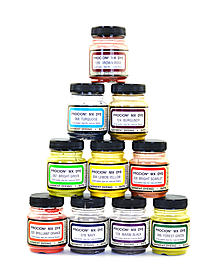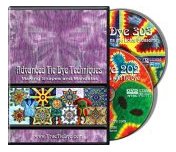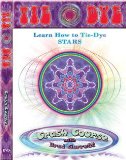Which is the relation between fabric weight and quantity of dyes? And, if soda ash has dried into the fabric, do I have to wet it again before applying dye?
Name: Mar
—ADVERTISEMENTS—
Large 8-ounce jars of Procion dye are more economical; don't forget to purchase soda ash, as well!
Procion MX Fiber Reactive Dye

Advanced Tie Dye Techniques: Making Shapes and Mandalas
by True Tie Dye

Tie Dye Crash Course - Stars
by Phat Dyes

How to Tie-dye Stars: Book 2 of the Tie-Dye Art Series
by Richard W. Rogers
Country or region: Panama
Message: Hello! Thanks for your time and sharing your experience. I have some questions: Which is the relation between fabric weight and quantity of dyes, I am tie dyeing sheets, and the best way to do it? Also, have some of them with the soda bath all ready on, to save time, they are dry now, when I want to dye them, do I have to wet them? In which substance? only water? or soda water? thanks!!
Use the same weight of dye per weight of fabric, in order to reach a particular color. If you use more fabric for the same amount of dye, by weight, you will get a lighter color overall. You should weigh your sheets, while they are dry, and then multiply the amount of dye, water, and soda ash you use by the same number, so that the dye will be the same concentration and the same color as when you are tie-dyeing smaller projects.
The best method for tie-dyeing sheets begins with using the right dye. Using an all-purpose dye or a direct dye will not work well for tie-dyeing, because these types of dye bleed from one part of the design to another. To create tie-dyed sheets in multiple colors, you should use a fiber reactive dye, such as Procion dye or Remazol dye. Soda ash (sodium carbonate) is the chemical that will set the fiber reactive dye; it will not help with all-purpose dye or direct dye.
You must use sheets that are made of natural fibers, not polyester. Cotton, linen, and rayon are all good. Sheets that have been treated to prevent wrinkling will not dye as brightly or evenly as untreated sheets.
To predict how much dye you need to use, see my page, "How much Procion MX dye should I use?". To tie-dye sheets that weigh three pounds (or 1.4 kilograms), you will need about 30 grams of Procion dye powder; you will need less if you are leaving a lot of white in your design, or more if you will not be leaving any white. Dissolve one-half to one cup (125 to 250 ml) of soda ash in each gallon (4 liters) of water, to soak your sheets in, just as when tie-dyeing clothing.
Pre-soaking the sheets in soda ash and then letting it dry is an excellent approach. The soda ash will stay in the fabric even after it has dried. There is no need to wet the sheets before dyeing them, if they have the soda ash dried into them. The dry soda ash will combine with the wet dye mixtures to enable the dye to react with the fiber.
You can soak the sheets in soda ash and then hang them up to dry, then tie them and apply the dye. Alternatively, you can tie the sheets while they are dry, or dampened with plain water, then soak the tied sheets in soda ash, then squeeze out extra moisture and allow the sheets to dry while they are tied. Of course it will take much longer to let the sheets dry if they are tied. You can apply the dye to sheets that are quite wet with soda ash mixture, or partially dried, or completely dry.
Some dyers prefer to work with dry fabric that has soda ash in it, while others prefer to work with wet fabric. If you do choose to rewet the sheets before dyeing, spray them lightly with only a small amount of water, so that you do not wash away any of the soda ash.
Fabric that has been soaked in soda ash solution and allowed to dry will have dry soda ash powder throughout the fabric. Be careful when handling these sheets. Soda ash has a high pH and is irritating to the skin, to your eyes, and to your breathing. Wear a face mask to keep the dry soda ash dust out of your nose and lungs, and wear thin plastic gloves to protect your hands from becoming red and dry. If you work with the sheets while they are still wet, you don't have to worry about breathing the soda ash; only the dry soda ash flies into the air where you can breathe it.
(Please help support this web site. Thank you.)
(Please help support this web site. Thank you.)
Posted: Wednesday - February 12, 2014 at 10:18 AM
Follow this blog on twitter here.
Quick Links
- All About Dyes & Dyeing Top -
- Top of this blog -
- FAQ -
- The Dye Forum -
- How to Tie Dye - How to Batik -
- Books - Toys - Plants -
- Top of this blog -
- FAQ -
- The Dye Forum -
- How to Tie Dye - How to Batik -
- Books - Toys - Plants -
More in this category:
- -
Statistics
Total entries in this blog:
Total entries in this category:
Published On: Jun 19, 2014 11:28 AM
Total entries in this category:
Published On: Jun 19, 2014 11:28 AM